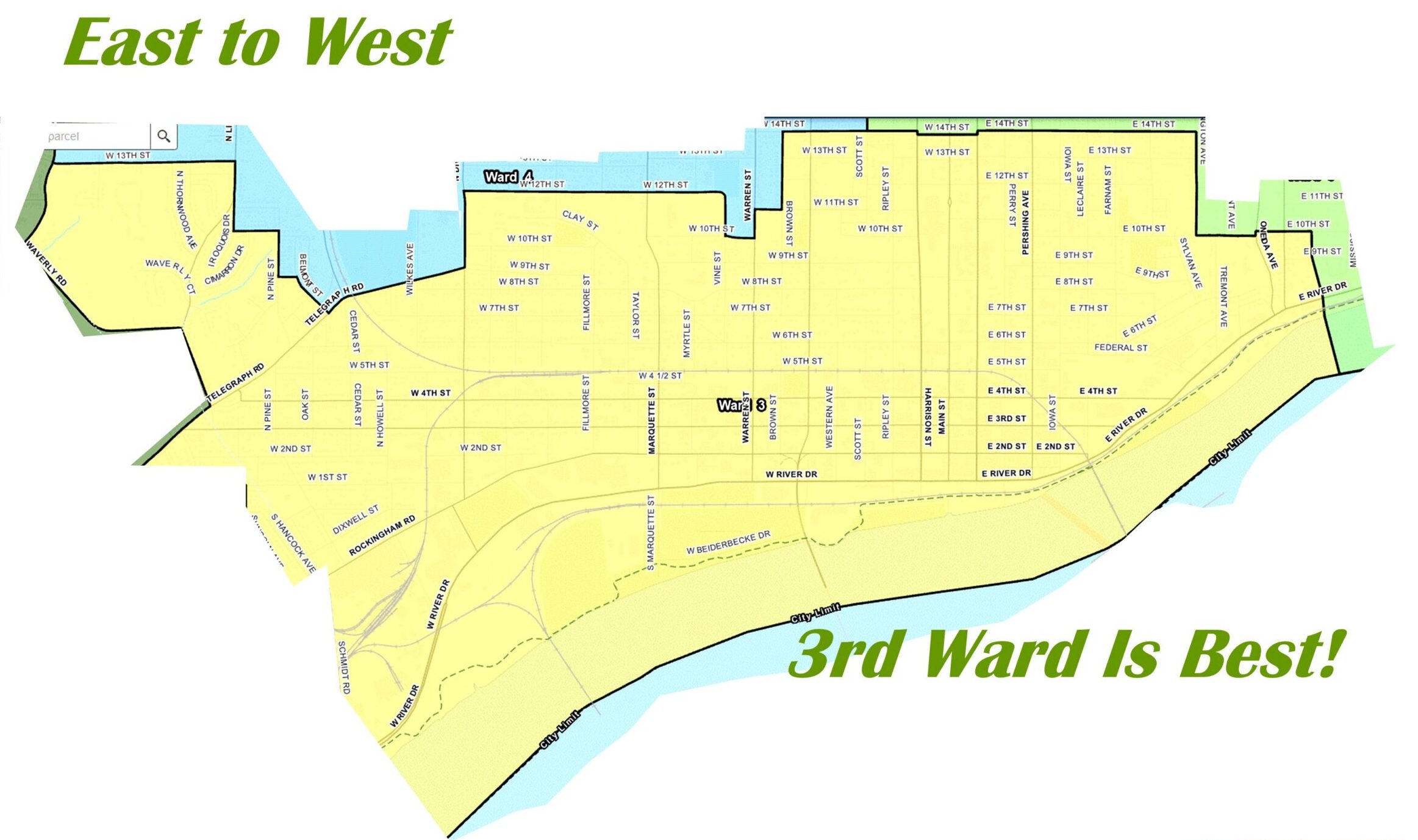Marion received a Masters in Historic Preservation from Goucher College in May 2018. Much of her coursework focused on Davenport. Here are some of her reports.
__________________________________________________________
Preservation in the Heartland: Revitalizing Davenport’s Heritage Neighborhoods
Marion’s master’s thesis, completed in 2018, argues that older neighborhoods, and the sense of place they create for residents, are a critical component to Davenport’s revitalization efforts. She defines these areas as “heritage” neighborhoods whether they have been formally recognized as historic or not. She examines Davenport’s preservation history, and looks at trends over time that have impacted these areas. She explores how other cities are dealing with these challenges, and offers options for Davenport to explore.
Click here for Preservation in the Heartland (6 MB)
Heart of the City: Revitalization in Heritage Neighborhoods Summary Report
Like Davenport, many cities across America are experiencing expansion in their historic business districts, as old commercial buildings are repurposed for new uses such as housing, restaurants and shops. Unfortunately, these same cities also are home to residential heritage neighborhoods who are struggling to find their place in the 21st century. “Heart of the City” explores how seven cities, including Davenport, are addressing this issue.
Over five months, three detailed reports were written noting various aspects of city management. This is the final, summary report that notes effective practices uncovered during the research.
Click here for the Heart of the City PDF(1MB)
Heart of the City : Interim Reports
Research on seven cities- Cincinnati and Dayton, Ohio; Buffalo and Syracuse, New York; Dubuque and Davenport, Iowa; and Macon, Georgia—generated the data for three interim reports that provided the findings and “Effective Practices” noted in the final “Heart of the City Summary Report.”
These interim reports provided an overview of each city’s current condition, reviewed its historic preservation management and enumerated historic infrastructure as well as exploring relevant governance practices, financial incentives and community partners and assets.
Click here for Heart of the City-Report1-Cincinnati-Dubuque-Syracuse
Click here for Heart of the City-Report2-Macon-Davenport
Click here for Heart of the City-Report3-Buffalo-Dayton
Going, Going, GONE! Preventing Demolition in Davenport’s Heritage Neighborhoods
This white paper examines the history of decline in Davenport’s urban core neighborhoods and argues that historic neighborhoods extend beyond those labeled as such by local or national Registers and that city policies have allowed their neglect to continue. It concludes with recommendations that can help to address recurring blight and restore these areas as attractive and healthy places to live.
The paper was written in 2016.
Click here for Going, Going Gone PDF(618KB)
Protecting Historic Buildings in Urban Core Neighborhoods: Tools within Iowa’s Code
With population growth averaging less than 3% per decade since 1920, including one devastating decade where the population dropped by 4.7%, the state of Iowa as well as her cities, including Davenport, struggle to maintain a balance between upholding the quality of historic housing stock and addressing issues within frequently decaying urban core neighborhoods.
Protecting Historic Buildings explores what factors caused Davenport’s historic neighborhoods to suffer from disinvestment and decay, why revitalizing them has been a priority for several municipal administrations and identifies legal tools within state and municipal codes that seek to address the issue.
The paper was written in 2015.
Click here for Protecting Historic Buildings in Urban Core Neighborhoods PDF(2MB)
Heritage in the Heartland
A Plan for Davenport
Davenport, Iowa, is rich in built heritage as evidenced by the more than 1600 structures listed in the National Register that call the city home.
Despite this, the city does not currently have a written plan for historic preservation. Heritage in the Heartland offers its readers background on the history of historic preservation, how it functions in the city, how local efforts relate to state and federal laws and code, and the challenges and opportunities facing it in 2016.
Heritage in the Heartland concludes with a set of five preservation goals along with objectives and actions to accomplish them.
The report was written in 2016.
Click here for Heritage In the Heartland PDF(5MB)
Intent and Outcome: A River City Retrieves Its Past
In 1979, the city of Davenport, Iowa, embarked on an ambitious plan to survey its historic structures and list them in the National Register of Historic Places. When the work was completed, more than 1600 structures had been listed in the Register, the largest number in the state. The initiative had its roots in the enthusiasm generated by the U. S. Bicentennial, new federal tax incentives and a reaction to state transportation proposals that threatened sections of the city’s old urban core. In the 1960s and 70s, Davenport’s population had continue to grow. But that growth came with consequences. Along with many cities across America, Davenport’s historic downtown and 19th century neighborhoods had lost businesses and residents to the suburban development in the outer edges of the city’s boundaries.
And there was another threat looming; as the city’s historic survey got underway, Iowa’s farmers had begun to reel from the impact of a farm crisis that would impact industry and jobs in the urban areas across the state; Davenport would not escape.
Intent and Outcome explores this dynamic era and its impact on local historic preservation. The paper was written in 2014.
Click here for Intent and Outcome PDF(6MB)
Back on Track: Revising Iowa’s State Historic Tax Credit Program
In 2000, Iowa joined a number of states offering tax credits for people restoring historic commercial properties. In 2006, legislators modified the program to allow owners of residential properties to receive credits for work done on their buildings as part of a Small Project fund.
The program has been successful in spurring millions of dollars in rehabilitation of buildings in Iowa. Unfortunately, successive changes in administrative rules have made a once simple program complicated and difficult for some Iowans to access, particularly owners of residential properties.
Back on Track explores the history of the program, explains how it differs from the federal program and argues for simpler rules for the Small Projects fund so that Iowa homeowners can more easily from the incentive.
The paper was written in 2016.
Click here for Back on Track PDF(707KB)
Do Small Places Matter?
The National Trust in promoting preservation of historic buildings encourages individuals to post pictures of structures under a “This Place Matters” banner. In this short paper, the author asks if “Small Places Matter” and explores the challenges to Davenport’s historic cottages, some of the city’s earliest surviving buildings, with particular attention to those remaining in the Hamburg Historic District.
The paper was written in 2016.
Click here for Do Small Places Matter? PDF(1MB)
Uptown Girl: The Andresen and the West End
In 1900, a new three story building was built at Western and W. 3rd Street across from Washington Square Park, a mixed commercial and residential neighborhood that was the heart of German Davenport. It was a new type of building for Davenport, Iowa, a city of single family homes. It was called the Andresen Flats, an upscale apartment house designed to appeal Davenport’s rising business class and named for the man who built it, H. H. Andresen, a German immigrant who had long owned the corner and who had prospered along with his adopted city.
Uptown Girl traces Davenport’s early beginnings and development as a prosperous Midwestern community. The history of the Andresen Flats and the ground upon which it was built provides a backdrop for the story of the Germans in Davenport, their contributions and the challenges they faced in the early decades of the 20th century.
Uptown Girl was written in 2015.
Click here for Uptown Girl PDF(8MB)
Historic Documentation: The William Allan and Lucy Birchard Foster House c 1872.
During the second half of the 20th century, the circa 1872 Foster House at 1412 E. River Drive in Davenport had been dramatically altered from its original appearance. As such, it was not included as an historic property in Davenport’s National Register surveys that took place beginning in 1979.
In 2002, Bob Yapp undertook a sensitive rehabilitation of the building that restored its Gothic Revival appearance.
This paper documents the history of the house, its builders, and the neighborhood that surrounds it and assesses its current condition using the Secretary of the Interior Standards for significance and integrity.
The paper was written in 2015.
Click here Foster House PDF(13MB)
George Krabbenhoeft House-Condition Assessment
At 716 W. 5th Street in Davenport stands the historic Krabbenhoeft House, an imposing two story building. The house is in need of immediate attention due to issues with the building’s envelope. Gateway Redevelopment Group is awaiting final action by Scott County that will transfer ownership of the property so that that work may begin. The paper is a condition assessment report of the property that details some of its early history, distinguishing architectural features and a two part action plan for remediation.
The paper was written in 2016.
Click here George Krabbenhoeft House PDF(5MB)
Nesbit Cottage
The Nesbit Cottage is an early clapboard building in Davenport’s Hamburg Historic District owned by Gateway Redevelopment Group. The paper details remediation to the building to stabilize it from seriously deteriorated condition. The information was originally posted on Preservapedia.com, but was reproduced here for easier access.
The paper was written in 2016.
Click here Nesbit Cottage PDF(1MB)

